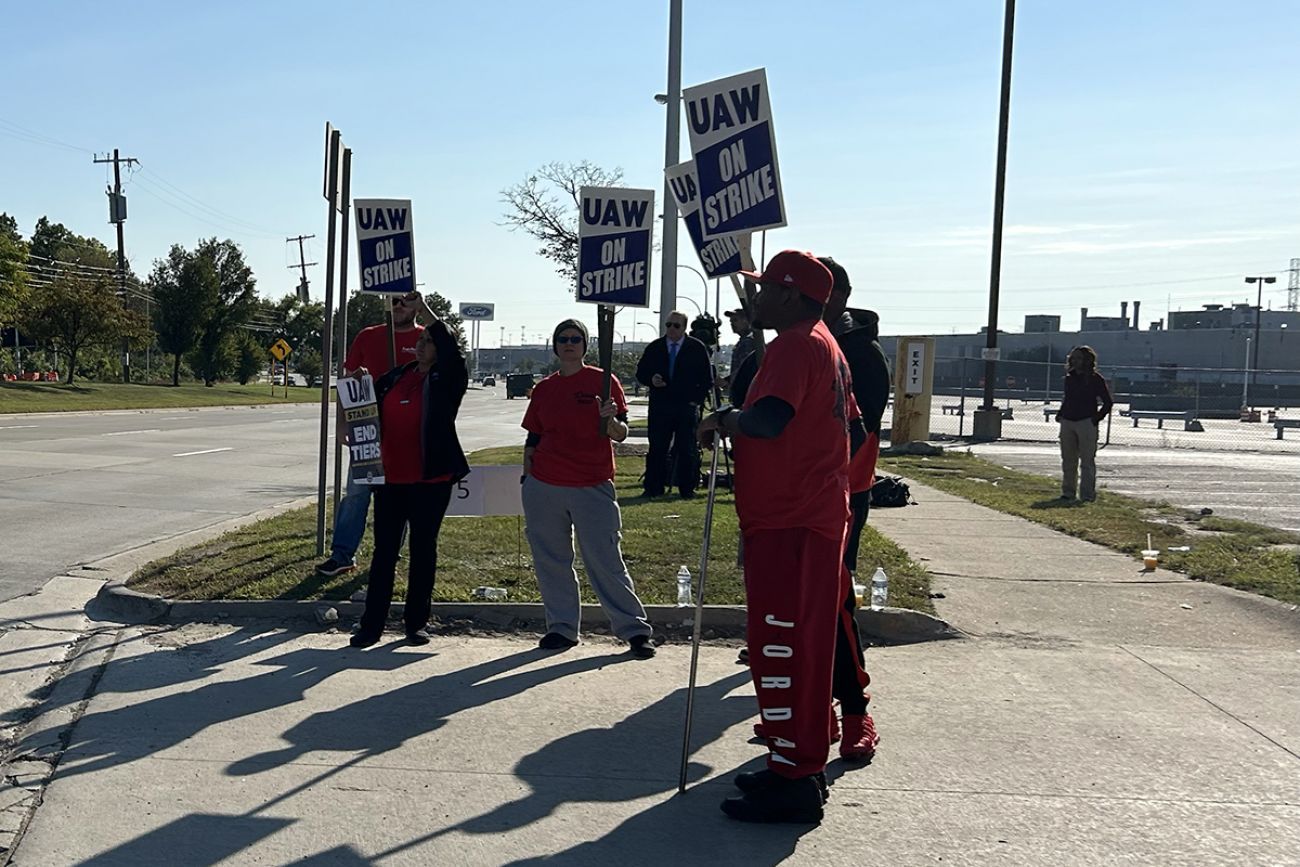UAW strike: 4 things to know as Michigan braces for it to spread

- The UAW is expected to announce Friday progress in negotiations with Detroit’s automakers or an expansion of its strike
- Few details on offers have been released since the strike began a week ago
- Effects of the targeted walkouts are growing across the auto industry
The United Auto Workers’ strike against Detroit’s three automakers is ending its first week Thursday with a cliffhanger: Will the strike expand on Friday, as the union warns?
“We don’t know,” Glenn Stevens, executive director of MICHAuto, the auto-focused division of the Detroit Regional Chamber, told Bridge Michigan Thursday.
The automakers — Ford Motor Co., General Motors and Stellantis — and union are on different sides of the negotiating table, but presenting similar fronts on confidentiality, Stevens said. That leaves little information on which to base a prediction.
Related:
- UAW strike 2023 updates
- Fain pushes back as Trump plans Michigan trip to court UAW
- UAW strike sets Michigan on uncertain path: ‘We’re nervous’
The strike has focused on three factories, one from each manufacturer: Ford’s Michigan Assembly in Wayne, GM’s Wentzville Assembly in Missouri and the Stellantis Jeep complex in Toledo.
UAW President Shawn Fain said he’ll disclose on Friday whether negotiations have progressed enough to avoid adding more factories to the walkout. He said he will present the information in a Facebook Live video at 10 a.m. Friday.
In the meantime, Stevens said, workers and management at other plants and Michigan’s automotive suppliers “are all holding their breath right now.”
Here are four things to know about dynamics of the strike as it unfolds at the end of Week 1:
1. The automakers have laid off non-striking workers, drawing UAW ire
Automakers say the strike is curtailing their ability to build vehicles, so layoffs within factories that were not yet targeted by the UAW for a walkout are starting to increase.
Fain criticized the moves Thursday, calling them an attack.
“If the Big Three decide to lay people off who aren’t on strike, that’s them trying to put the squeeze on our members to settle for less,” Fain said.
“With their record profits, they don’t have to lay off a single employee. In fact, they could double every autoworker’s pay, not raise car prices, and still rake in billions of dollars.”
So far, layoffs have not reached deeply into Michigan except for about 600 workers at Ford’s Michigan Assembly who were laid off shortly after the strike began in a portion of that plant.
Stellantis announced Wednesday that 368 workers at two plants would be idled. Some are in the Toledo Machining Plant in Perrysburg, Ohio, near the Jeep complex. Additional layoffs are coming to the Kokomo, Indiana, transmission and casting plants.
About 2,000 workers in Fairfax, Kansas, learned Wednesday they are being laid off. GM had said the assembly factory could run out of parts this week, confirming to WDAF-TV in Kansas City on Wednesday that the UAW walkout at the Wentzville stamping plant near St. Louis created a “negative ripple effect." The Fairfax factory uses metal parts from Wentzville to make the Chevrolet Malibu and Cadillac XT4.
2. Automakers may be in different stages in contract talks
Public announcements about proposals and bargaining have not been released daily by the Big Three, leaving big gaps in understanding where each stands with the UAW.
Ford, for example, has not publicly disclosed information since early in the strike. It said last week it had submitted four proposals, the latest including a wage increase with cost-of-living adjustments (COLA).
Ford just reached a tentative deal Tuesday with Unifor, the union representing its Canadian workers. Details have not been released, but the agreement — which still needs to be ratified — came without a strike.
Stellantis said it made a new offer to the UAW this week, but did not provide details. On Monday, it said negotiations had resumed, saying “discussion was constructive and focused on where we can find common ground to reach an agreement that provides a bridge to the future by enabling the company to meet the challenges of electrification.”
GM, in contrast, on Wednesday published a statement called “Setting the record straight.” In it, it outlined UAW demands and the automaker’s response — and contested how union leaders characterized GM’s offers.
The GM statement noted, for instance, the UAW seeks wage increases of 46 percent, compounded over a four-year contract, while GM offered 20 percent. That amount would leave about 85 percent of hourly workers making a base wage of $82,000 per year.
“The fundamental reality is that the UAW’s demands can be summed up in one word — untenable,” the company said.
Early Thursday evening, GM posted a second statement, which it called, “GM’s Latest Offer: What’s in it for me?” The company set up information grids for four classifications of workers, showing provisions in GM’s “record offer” on Sept. 14 and what it would mean for workers.
3. In Michigan, strike impact is spreading quickly among auto suppliers
LM Manufacturing of Detroit announced Thursday it laid off 650 workers, just months after the factory, which makes seats for the Ford Bronco, opened.
The layoffs show how the strike is rippling beyond the three automakers, Stevens said.
While many people and businesses in Michigan may not be experiencing any effects from the strike, “there are people whose livelihoods are impacted,” Stevens said. “And that's serious business.”
John McIlroy, host of Autoline, a web-based auto reporting site, noted at a Detroit Regional Chamber panel Thursday that auto manufacturers built about 8 million fewer vehicles during the three years of COVID-19 supply shortages. They raised prices, as did auto dealers, McIlroy said.
Suppliers, though, lost sales volume and “they were not able to recoup it … and so they’re severely stressed.”
Stevens said some salaried workers at suppliers are facing a week of furlough. ln the worst cases, if the strike continues, he said some suppliers are likely to close. Michigan is home to about 1,000 supplier facilities.
4. Contract costs could result in labor losses
Up to 10 percent of the cost of operating auto companies is labor, and UAW demands — if met — would “more than double the hourly costs of the workforce,” Marick Masters, professor of business at Wayne State University, said Thursday during the chamber panel.
Wage increases of 30 percent and bonuses could be absorbed, Masters said, though they would eat into revenues.
Many are most closely watching demands for cost-of-living increases on top of wage increases, restored pensions and the union’s demand for a 32-hour work week for 40 hours of pay.
Those, Master said, are “the real budget-busters …. (that would put them) at a real disadvantage” as they compete against foreign automakers and Tesla and their non-union workforces.
If adopted, each automaker would need to consider substituting capital for labor — or investing in automation to replace workers, and other ways to reduce the cost of production.
Detroit automakers faced a crisis in the 2000s over legacy costs like pensions, with GM and Chrysler, now part of Stellantis, filing for bankruptcy.
“I don’t see how they go back to where they were and have any future ahead of them,” Masters said.
Business Watch
Covering the intersection of business and policy, and informing Michigan employers and workers on the long road back from coronavirus.
- About Business Watch
- Subscribe
- Share tips and questions with Bridge Business Editor Paula Gardner
Thanks to our Business Watch sponsors.
Support Bridge's nonprofit civic journalism. Donate today.
See what new members are saying about why they donated to Bridge Michigan:
- “In order for this information to be accurate and unbiased it must be underwritten by its readers, not by special interests.” - Larry S.
- “Not many other media sources report on the topics Bridge does.” - Susan B.
- “Your journalism is outstanding and rare these days.” - Mark S.
If you want to ensure the future of nonpartisan, nonprofit Michigan journalism, please become a member today. You, too, will be asked why you donated and maybe we'll feature your quote next time!




